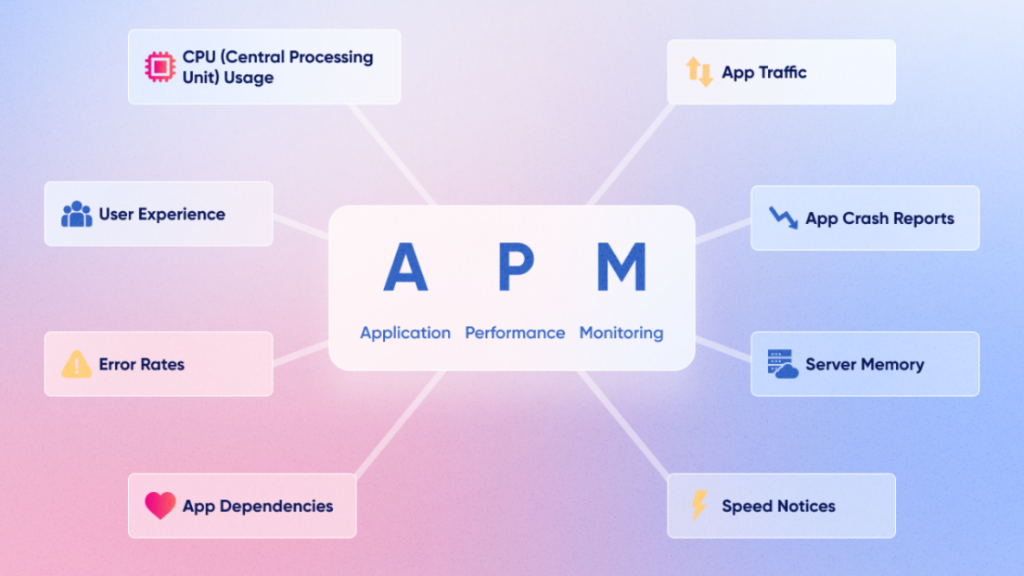Is your business experiencing a lag in application or is there a problem with the application? The solution for this is Application Performance Monitoring (APM). APM will give the true picture of your application or system as it is running and it will point to any bottlenecks or problems you may have with your application.
By following the response times and error ratios, APM allows the developers and IT specialists to optimally upgrade to higher sophistication and user satisfaction. Below, we will go over the basic ideas of APM, describe best practices, and give examples of effective implementation of this methodology. Welcome to APM – the key to optimising your application’s performance!
Why is APM Important for Businesses?

APM is becoming essential in today’s environment and even more so when considering gigantic steps businesses are taking towards digital transformation. Sluggish application performance is one of the biggest sources of user dissatisfaction, lost sales, and damaged brand image. APM is a method that prevents problems from arising, and is used specifically to prevent possible user inconvenience.
Some APM tools give visibility into response time as well as level of errors and allow management to make correct decisions with regards to allocation of resources as well as performance improvement. It also enables rapid monitoring of service delivery and guarantees high service delivery levels hence enhancing customers loyalty. Also, APM enhances the interaction of development and operations teams proactively involving the performance criteria within the ochre of software development life cycle. Finally, APM is the company’s competitive weapon that will help manage organisational performance in the context of digitalization.
Key Metrics and Indicators for APM
Application performance management is therefore best managed through the observation of parameters that show the ability of an application to perform. Important metrics include:
1. Response Time: It defines how fast an application can process user inputs. Poor response time is not well tolerated by users who may be prompted to abandon the activity in question midway.
2. Throughput: This shows the flow of transaction volumes within the day or within a given period whether in inlet or outlet. High number of operations per time indicates that the application can easily and efficiently handle a large number of requests, especially in the busiest of times.
3. Error Rates: Catching errors like crash or failed transactions is very important for problematic detection before they ever reach the users.
4. Resource Utilisation: CPU and memory usage are examples of ways to measure how effectively an application utilises capacities of the infrastructure. High use may indicate load and probably problems in performance.
Through these measures, businesses can value their application understanding and decision-making of systems optimization.
Tools and Technologies for APM
It is very important that the right Application Performance Monitoring (APM) tools are chosen for the task of monitoring. Here are some popular APM solutions, each offering unique features:
1. New Relic: Praised for its straightforward openness, New Relic offers comprehensive analytical tools for application performance, which can help a company better understand processes and possible slowdowns through easy-to-read visualisations.
2. AppDynamics: This tool concerns the demonstration of the correlation between application performance and business objectives; this enables organisations to determine the level of performance and the level of user conversion. It provides full-stack observability, which allows teams to manage and analyse application performance metrics properly.
3. Dynatrace: Thanks to artificial intelligence, which is integrated into the Dynatrace environment, monitoring and problem identification happen automatically, which means that potential issues are solved before they become critical.
These APM tools need to be incorporated into the existing DevOps workflow to bring performance monitoring into the SDLC. Essentially, for a business to improve application performance, it needs to acquire the right APM solutions.
4 Steps Of Choosing the Proper APM Strategy for Your Firm

- Establish Clear Objectives: From this case, it is important to state that concrete targets need to be set on what needs to be accomplished through APM activities, which can be goals such as a control of the response time or improvement of user satisfaction with services provided by the IT department. The development of the evaluation should be in the format of criterion solution with the Application of the SMART criteria namely Specific, Measurable, Achievable, Relevant and Time bound.
- Choose the Right APM Tools: Select tools of relevance in setting goals and surrounding arrangement. As for those factors, one should consider such issues as scalability, compatibility with into account such issues as scalability, compatibility with the current environment, applications already in place, and the cost. Engage key workers from the development side of the tools as well as those who will manage and use the tools to meet their complexity of needs.
- Define Monitoring Parameters: There are things that should be emphasised or highlighted such as, response time, capability, and frequency of failure. This will help you deal with the interrogative stages so that you can filter into relevant aspects for your applications.
- Train Your Team: Make sure all your team members get adequate training on the APM tools that you plan to use so that they can be in a position to interpret performance data analytically, and not only by department.
Under funding secure coordination data from experience obtained and revise contingencies. Remember to always interact with the user at the end of the application so as to garner useful information about how the application is performing.
Best Practices for Effective APM
1. Adopt a Proactive Approach: Instead of waiting for users to report such, constantly check the applications for signs of such activities. Provide basic notification for a quick action against any problem.
2. Prioritise User Experience: Monitor time and activity to users, thereby being able to understand areas that need change and improvement.
3. Foster Collaboration: Develop dialog between the development and the operation teams in order to enhance the problem solving and resolve e issues as soon as possible.
4. Following these steps, and the best practices outlined in this paper, organisations will be able to build a strong APM strategy that delivers superior application performance, and ultimately, impressive business value.
Case Studies: Success Stories of Businesses Using APM
Real-world examples illustrate the transformative impact of Application Performance Monitoring (APM) on businesses:
- E-Commerce Platform: An e-commerce site used web performance best practices on a popular platform but struggled during Black Friday and other high traffic periods to load pages and experiences. They implemented an APM solution and got insight on how to unlock the bottlenecks and enhance their infrastructure by managing to reduce page load times to 50%. This enhancement greatly improved the perception of the site by users and led to a greater number of conversions.
- Financial Services Company: Suffering from system failure which caused application downtime this organisation led to loss of revenue together with customer dissatisfaction. Lastly, with the properly implemented APM strategy in place, they were able to observe most applications in real-time and contain problems before they emerged. By making this approach, they cut down their downtime to a third hence helped them enhance high services as well as proper utilisation of resources leading to major costs saving.
- Healthcare Provider: A case of APM for improving the performance of a health care organization’s patient management system. Engaging DevOps enabled them to have visibility into the application and user interactions hence cutting on patient waiting time hence improving on service delivery.
These success stories illustrate how APM is capable of achieving very massive enhancements in application performances and indeed business performances.
Future Trends in APM

Application Performance Monitoring (APM) has continued to change and is experiencing the introduction of Artificial Intelligence (AI) and Machine Learning (ML). These technologies complement APM tools by allowing for the processing, forecasting, and fixing of problems as well. Organisations are now able to predict performance problems that may ensue later and this improves organisational performance greatly.
The third trend is the change of tracking sense in favour of monitoring of users experience rather than using metrics. This includes the observation of user activity and satisfaction levels, so that organisations can improve upon their decision making concerning the appearance of applications.
Further, with total software consumption shifting to cloud-native applications and microservices, it becomes critical to have APM tools that fit into new application architectures and provide extensive visibility for superior performance in various environments.
Conclusion: The Impact of APM on Business Performance
APM is critical in any current day business frameworks since it offers important data that aids efficiency, optimization of outcomes and high levels of customer satisfaction. Originally, APM helps manage the performance issues before they degenerate and coordinate different teams within an organisation. Testimonials prove its efficacy, highlighting the positive changes that APM brings, and how its implementation brings an ROI.
The digital era represents an opportunity for those companies that will learn how to update APM as AI improves, focus on the user experience, and implement cloud-native technologies. Implementing APM also improves technical effectiveness and application performance, but it also helps to improve business results. APM stocks are good for the long term investment in the current market and the key to success in arguably the most challenging climate.

